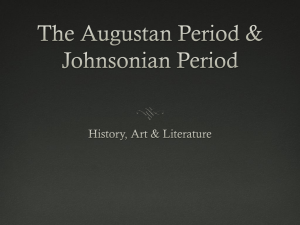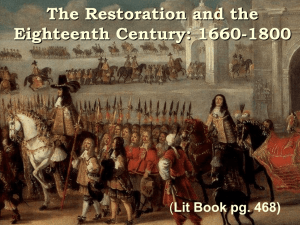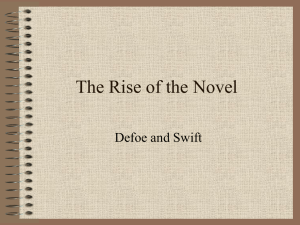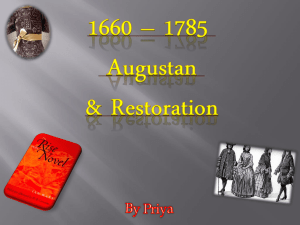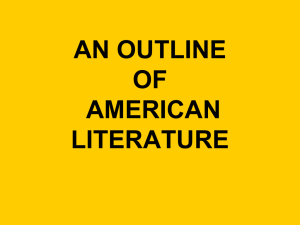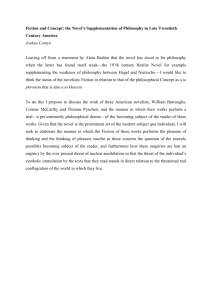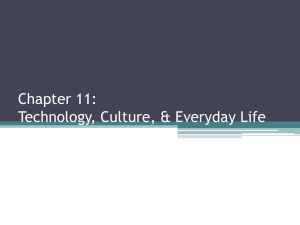Augustan Literature
advertisement
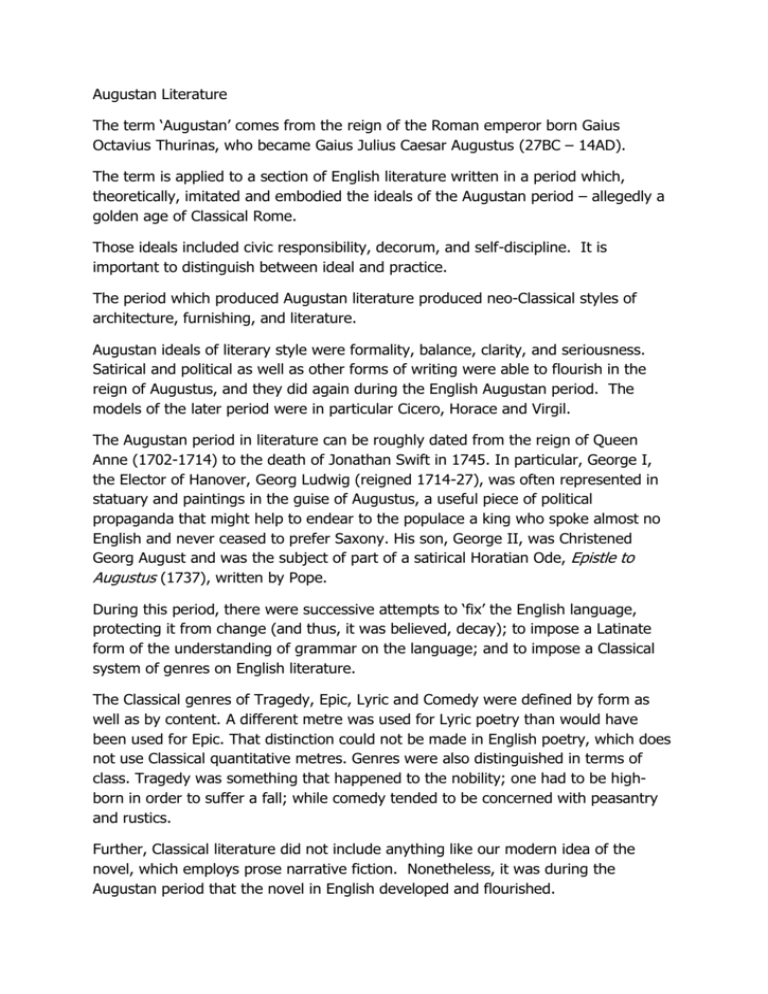
Augustan Literature The term ‘Augustan’ comes from the reign of the Roman emperor born Gaius Octavius Thurinas, who became Gaius Julius Caesar Augustus (27BC – 14AD). The term is applied to a section of English literature written in a period which, theoretically, imitated and embodied the ideals of the Augustan period – allegedly a golden age of Classical Rome. Those ideals included civic responsibility, decorum, and self-discipline. It is important to distinguish between ideal and practice. The period which produced Augustan literature produced neo-Classical styles of architecture, furnishing, and literature. Augustan ideals of literary style were formality, balance, clarity, and seriousness. Satirical and political as well as other forms of writing were able to flourish in the reign of Augustus, and they did again during the English Augustan period. The models of the later period were in particular Cicero, Horace and Virgil. The Augustan period in literature can be roughly dated from the reign of Queen Anne (1702-1714) to the death of Jonathan Swift in 1745. In particular, George I, the Elector of Hanover, Georg Ludwig (reigned 1714-27), was often represented in statuary and paintings in the guise of Augustus, a useful piece of political propaganda that might help to endear to the populace a king who spoke almost no English and never ceased to prefer Saxony. His son, George II, was Christened Georg August and was the subject of part of a satirical Horatian Ode, Epistle to Augustus (1737), written by Pope. During this period, there were successive attempts to ‘fix’ the English language, protecting it from change (and thus, it was believed, decay); to impose a Latinate form of the understanding of grammar on the language; and to impose a Classical system of genres on English literature. The Classical genres of Tragedy, Epic, Lyric and Comedy were defined by form as well as by content. A different metre was used for Lyric poetry than would have been used for Epic. That distinction could not be made in English poetry, which does not use Classical quantitative metres. Genres were also distinguished in terms of class. Tragedy was something that happened to the nobility; one had to be highborn in order to suffer a fall; while comedy tended to be concerned with peasantry and rustics. Further, Classical literature did not include anything like our modern idea of the novel, which employs prose narrative fiction. Nonetheless, it was during the Augustan period that the novel in English developed and flourished. 2 The genre with which Augustan literature is most readily identified is satire. Political - and personal – satire appeared in all forms: narrative fiction; poetry; drama; journalism; and the latter is particularly important in this period. This is the age of the coffee-house and the coffee-house periodical. The Augustan age coincides with the later Enlightenment, sometimes called the Age of Reason, when scientific and rational discourses are said to have begun to replace religious, superstitious and other ways of seeing and understanding the world., though of course this must be a simplification. Certainly, scientific institutions such as the Royal Society became prominent at this time, and discoveries were made in astronomy, medicine, navigation, chemistry, biology and physics which changed the way we see the world and its place in the universe. Although this was the Age of Reason and the Age of Elegance it was also the age of criminality, poverty, dirt, disease, and corruption. The spirit of the age was captured, as he saw it, by artist William Hogarth, in a series of satirical sketches known as The Rake’s Progress. Another advance that was perhaps more important for Augustan literature was the advance in print technology. The price of printed books fell, and the number of copies that could readily be printed grew, and this coincided with a rise in literacy, and thus in the demand for inexpensive books. The transactions of the Royal Society were published, as were other works of research and science, with keys and digests to explain their import to non-specialist readers. Works of more immediate practical application were also published, on animal husbandry, agriculture, and, in a burgeoning genre, social problems. Many works offered solutions to social and economic ills – some sensible, others impractical, others ridiculous, and this later developed into a rich vein for satire. We should not exaggerate this. Many people remained illiterate, and books remained far too expensive for many people who could have read them, but for the enlarging middle class with some disposal income, books became within reach. Without the classical education of the well-born and wealthy, they tended to avoid the poetry of the era, but novels became a popular, and respectable, way of filling their new leisure time. Books were not the only printed media available. Chap books and broadsheets were distributed throughout the country, apprising people outside the capital of the news, debates, and scandals of the day. Many periodicals came into being in this period, chiefly, The Gentleman’s Magazine (1731), The London Post (1699), The Tatler, 1709, succeeded by the The Spectator (1711). The Tatler and the Spectator, founded by Richard Steele, were popular among the middle-classes. A tax was imposed on newspapers in 1712 which made them expensive for the less well-off individual. Many periodicals would have been read in coffee-houses, however, which were like a combination of a modern café and a gentleman’s club. 3 The first was in Oxford, but soon after they appeared all over London. Men went there to smoke their pipes, drink coffee, read newsletters and periodicals, and converse. Some coffee-houses had runners to bring details of the latest news. Different London coffee-houses became associated with different social groups, depending on their location, so that those in Westminster tended to attract politicians, whilst those near St Paul’s attracted clergymen, and the Fellows of the Royal Society met at the Graecian. They also divided politically. The Whigs met at the St James’s and the Tories at The Cocoa-Tree, both in Pall Mall. Poet and dramatist John Dryden patronised Will’s coffee-house in Covent Garden just before our period, and attracted to it a circle of admirers and fellow-authors. Next to become fashionable was Button’s coffee-house, patronised by Addison and Steele and their circle. As the demand for inexpensive up-to-date publications rose, so did the profession of hired writer, or hack, who was usually paid by the word and printed anonymously or pseudonymously. These were despised by authors such as Alexander Pope, who clung to the old idea that writers should receive an income from patrons rather than from the sale of their works, but treated rather more realistically by Addison and Steele. Hogarth satirises ‘Grub Street’ – a generic name for the fruits of such writing which comes from a street in London which became a writers’ colony – in a painting known as ‘The Distress’d Poet’. Although he didn’t live in Grub Street, Defoe was the greatest hack of them all. He edited and contributed to a number of publications, sometimes writing under different pseudonyms, reviewing his own work, and answering letters which he had also written. His Robinson Crusoe first appeared in a periodical, The London Post, in 1719. Fiction Initially there was no clear-cut distinction between factual and fictive writing. The novel had a number of ancestors: the biography; the work of speculation; and journalism in prose non-fiction, and the Romance; long narrative poem; and fairy and folk tales in fiction. The first novel is difficult to identify. Its precursors could be as early as John Lyly's Euphues (1579) or Sir Philip Sidney's Arcadia (1590) or John Bunyan's Pilgrim's Progress (1684). More recognisable, perhaps, are Aphra Benn’s Letters Between a Nobleman and his Sister (1683) and Oroonoko (1688). In the August period, Daniel Defoe’s Journal of the Plague Year (1722) mixes fact and fiction in a journalistic style and a number of novels claim for themselves a kind of authority by offer their stories as fact. Early novels often have subtitled such as ‘A True and Faithful Account of...’ or ‘As Related to the Author...’ They are also often ‘framed narratives’, that is, they have an introductory section in which the author 4 asserts that he or she found the story in a mss in an old chest, or was the recipient of the last dying gasp of an ancient seaman. The Fortunes & Misfortunes of the Famous Moll Flanders &c. Who was Born in Newgate, and during a Life of continu'd Variety for Threescore Years, besides her Childhood, was Twelve Year a Whore, five times a Wife (whereof once to her own Brother), Twelve Year a Thief, Eight Year a Transported Felon in Virginia, at last grew Rich, liv'd Honest, and dies a Penitent. Written from her own Memorandums … [also see Crusoe] As the prose fiction evolved, authors tested its possibilities, trying out forms such as the epistolary novel (the novel in letters), the picaresque (the humorous and fantastical journey-novel), the bildungsroman (the novel charting the journey from youth to maturity), the roman à clef (the story which needs a key, i.e. its characters are lightly-disguised portraits of real people) the story within a story, the first-person narrative, the third-person narrative, the intrusive narrator, and the multiple perspective. Women Augustan authors contributed to this evolution, in particular Mary Delariviere Manley, who wrote The Secret History of Queen Zarah and the Zaraians (1705) and The New Atalantis (1709), Eliza Heywood, who wrote Love in Excess (1719) and Jane Barker, who wrote Loves Intrigues: Or, The History of the Amours of Bosvil and Galesia (1713). The most famous of the texts fully-recognisable as novels from this period are perhaps Defoe’s Robinson Crusoe (1719), Moll Flanders (1722) and Roxana (1724). There was a market for novels telling of scandals and romance in high life, and for lurid tales of the criminal classes, whether unregenerate scoundrels or people down on their luck and forced to survive in an emergent capitalist society with little more than their wits. In order to attain any kind of status as literature, however, the novel had to claim for itself a function as more than escapist or entertaining. The hierarchy of literary genres still had at its head Classically-inspired and modelled poetry, followed by belles-lettres, essays, history, biography, and other forms of non-fiction. In addition, there were complaints that reading fiction gave people ideas above their station and made them dissatisfied with real life. It was said to be particularly injurious to women. In response, stress began to be laid upon the educative and moral function of the novel. 5 Criticism The circle of Pope, Addison, Steele and Swift was able to influence the taste of the age and to lay down precepts for how literature should be. Augustan literature as formalised by Alexander Pope consciously imitated the methods and forms of Classical literature, and admired the art and artifice of the works True ease in writing comes from art, not chance, As those move easiest who have learn'd to dance. 'Tis not enough no harshness gives offence, The sound must seem an echo to the sense. (An Essay on Criticism II ll. 3625) Those rules of old discovered, not devised, Are nature still, but nature methodized. It did adapt Classical forms, however, in particular developing the mock-epic and mock-heroic, which were used to humorous and satirical effect. Satire Pope’s The Rape of the Lock (1714) is a mock epic, that is, a piece in which the commonplace is treated in exalted, portentous language more usually associated with High Seriousness. The commonplace is a boat-ride and a card game, and the lock is stolen lock of hair. It is based on a real-life squabble between Arabella Fermor and Lord Petre. His The Dunciad (1728), also a mock epic, is sometimes vicious attack on critics and lesser writers of the day. In Jonathan Swift's The Battle of the Books (1704), clashes of intellect, philosophy and outlook between ancient and modern thinkers are reduced to a fight between a bee and a spider. Swift's Gulliver's Travels (1726) is another kind of satire. Ostensibly a travel narrative which takes Lemuel Gulliver to far-off and strange lands, it satirises the hypocrisy, stupidity, bureaucracy, and gullibility that Swift saw in his own time and place. The High Tory Catholic Pope was one of the founders of the Scriblerus Club, an association of writers including John Gay, Jonathan Swift and and John Arbuthnot, dedicated to the satirisation of pedantry, fakery and ignorance. Poetry Satirical poetry was often written in iambic lines which rhymed aa, bb, cc – heroic couplets. Other poetry might have more complex and interlaced rhyme-schemes, and the four-line stanza – the quatrain – was much used. Earlier in the period, locodescriptive poetry – the poetry of place – was popular, as was poetry which minutely described aspects of nature, such as James Thomson’s The Seasons. Later 6 in the period, poetry tended to take on a darker, more melancholy strain, as with Edward Young’s The Complaint: or, Night Thoughts on Life, Death, and Immortality (1742-45), usually known as Night Thoughts. Pope’s Essay on Man Know then thyself, presume not God to scan, The proper study of mankind is man. Plac'd on this isthmus of a middle state, A being darkly wise, and rudely great: With too much knowledge for the sceptic side, With too much weakness for the Stoic's pride, He hangs between; in doubt to act, or rest; In doubt to deem himself a God, or beast; In doubt his mind or body to prefer; Born but to die, and reas'ning but to err; Alike in ignorance, his reason such, Whether he thinks too little or too much: Chaos of thought and passion, all confus'd; Still by himself abus'd or disabus'd; Created half to rise, and half to fall; Great lord of all things, yet a prey to all; Sole judge of truth, in endless error hurl'd: The glory, jest, and riddle of the world! Drama Augustan drama followed the bawdy and licentious but witty and mannered Restoration drama, which reflected the interests of the king and court. With much less royal interest and patronage, Augustan drama tended to reflect the interests of businessmen and the bourgeois, and tended to develop towards moral dilemma and melodrama, though there were plays which presented political debates and even propaganda, for example Joseph Addison’s Whig play Cato, Henry Fielding’s Tom Thumb (1730) and Covent Garden Tragedy (1732), John Gay’s Beggar’s Opera (1728) which was an attack on the Prime Minister, Robert Walpole. Throughout the period, whilst literary plays by, for example, George Lillo and Richard Steele (The Conscious Lovers (1722)) were staged, theatre managers were often induced to present plays which consisted mostly of spectacle, written by hired hacks, as this avoided payments for rehearsals and the customary third-night benefit performances to playwrights. Augustan drama was dealt a severe blow in 1737, with the implementation of the Theatrical Licensing Act, which gave the Lord Chamberlain the right to approve any 7 play before it was staged, and thus the power to censor any play considered subversive or politically dangerous. Poets and satirists Alexander Pope Jonathan Swift John Dryden Fiction and ‘faction’ Eliza Heywood Jane Barker Daniel Defoe Dramatists John Gay Lexicographer, essayist Samuel Johnson (later work slightly out of the period), Dictionary of the English Language (1755) Essayists and periodical editors Joseph Addison Richard Steele Criticism / didactic writing on literature John Dryden, An Essay of Dramatic Poesy (1668) Alexander Pope, Essay on Criticism (1711)
